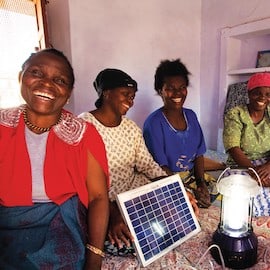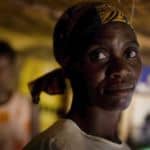For these of us who’ve dependable entry to vitality, it’s straightforward to neglect precisely how transformative that know-how is, or how far its advantages prolong into our every day lives. However practically every thing that makes it attainable for us to stay safely and with dignity — from healthcare and schooling to meals safety and private security — depends basically on vitality. That’s the reason we at Open Capital have spent greater than a decade working intensively with companies, buyers, growth companions and governments in sub-Saharan Africa (SSA) towards the aim of common vitality entry. However on this time, we’ve additionally seen {that a} essential side of the dialog is usually ignored — specifically, the truth that vitality entry can also be an engine for gender equality.
Whereas each women and men in SSA lack entry to electrical energy and protected, dependable clear vitality applied sciences, in practically each means conceivable, girls within the area pay a much bigger worth for this lack of entry than males. Girls in rural areas bear huge burdens of each time and well being as they spend a median of 1.4 hours per day gathering gasoline wooden and leaning over smoky fires or gasoline stoves to cook dinner. Equally, SSA girls face huge alternative prices by having their lives tied up within the labor-intensive duties of cooking, cleansing and heating with out fashionable vitality applied sciences. Consequently, girls dwelling in vitality poverty have much less entry to schooling and are much less more likely to be employed exterior the house, usually making them extra depending on the boys of their lives.
From these examples, it’s clear that vitality poverty in SSA shouldn’t be gender blind. Due to this fact, we consider that increasing vitality entry on the continent can’t be gender blind both. Specifically, girls’s wants should be positioned on the heart of the design, growth and advertising of the low-cost merchandise bringing vitality entry to the world’s most weak individuals. On the coronary heart of this transformation are the actions of three key gamers: the businesses that make vitality merchandise, the funders who assist each the producers and the top customers of those merchandise, and the policymakers who set the agenda in Africa’s vitality sector.
We now have already seen examples in our work of how prioritizing girls’s wants in all of those realms makes vitality entry extra equitable and sustainable within the area. Listed here are a number of the greatest classes we’ve discovered alongside the way in which.
The shopper is queen and needs to be listened to
We already know that ladies are the first customers of low-cost vitality options like clear cookstoves, biomass digesters and photo voltaic house programs. Due to this fact, it’s essential that the businesses that make these merchandise have interaction girls intently of their growth. For instance, we not too long ago labored with an organization designing transportable photo voltaic battery packs for off-grid communities throughout sub-Saharan Africa. Of their preliminary design, the batteries weighed 30 kilograms every. Nonetheless, as the corporate started advertising the product, they realized that many ladies weren’t serious about shopping for it as a result of the batteries have been too heavy for them to hold. Primarily based on this suggestions, the corporate lowered the battery pack dimension to 10 kilograms, guaranteeing that ladies clients weren’t excluded from utilizing the product.
To assist them higher perceive the wants of their feminine clients, this firm made a deliberate effort to have interaction girls as gross sales brokers, which created an environment friendly suggestions loop that knowledgeable the work of their product designers. This use of feminine gross sales brokers has develop into widespread within the trade: Notably in rural African communities the place gender roles and norms are strict, girls usually have higher entry to different girls, and may due to this fact be simpler at explaining new vitality merchandise to this significant market, in addition to soliciting their suggestions. For example, WID Vitality, a photo voltaic house system distributor in Southern Africa, has a gross sales group that’s 40% girls, which — because the Worldwide Vitality Company notes — permits the corporate to “obtain a bigger attain” since feminine brokers are “usually higher at convincing households and communities” to undertake new clear vitality options. Extra broadly, gathering the sex-disaggregated person expertise knowledge that’s enabled by girls gross sales brokers serving girls clients helps make sure that decision-makers on the forefront of creating new vitality merchandise are assembly the complete vary of a market’s wants and preferences.
Nonetheless, firms advertising low-cost clear vitality options also needs to concentrate on the actual financing challenges that feminine customers face. In lots of energy-impoverished communities, girls have decrease incomes than males and are much less more likely to personal property or different belongings they might use as collateral for loans. Due to this fact, they’re usually higher supported by fee fashions that distribute the prices over a very long time interval, reminiscent of leases or pay-as-you-go (PAYGo) programs. This shopper financing mannequin has labored significantly effectively within the photo voltaic house programs area, with an IGC examine in Tanzania displaying that entry to PAYGo photo voltaic lamps can improve the probability of girls working exterior the house: This improve is equal to 40 further minutes of paid work.
Unlocking clear vitality financing options can shut the gender hole
Making the clear vitality sector extra gender inclusive may also require elevated intentionality on the a part of funders — each those that again the companies that make low-cost vitality merchandise and people supporting the customers who purchase them. At a fundamental degree, women-owned small and medium enterprises (WSMEs) are vastly underrepresented within the African vitality sector, with an estimated $42 billion financing hole for girls entrepreneurs throughout industries on the continent.
Supporting WSMEs within the vitality sector is pivotal partly as a result of, in our expertise, these firms are naturally extra inclined to think about girls throughout the size of their provide chains — from their administration all the way down to their distributors and finish clients. For instance, we not too long ago labored with a woman-owned firm producing biodigesters — a tool that turns natural waste into biogas and fertilizer — for rural and peri-urban communities in Japanese Africa. As a result of the founder knew the product would largely be utilized by girls, she made a deliberate level of creating a mostly-female group throughout govt, technical and gross sales roles. Consequently, the corporate has achieved a bigger feminine buyer base than its rivals.
In essence, firms like this one spotlight the influence on girls finish clients of gender lens funding, an funding technique the place funders take into account influence on girls as a measure of “success,” alongside extra standard metrics like revenue or gross sales development. Within the vitality sector, gender lens financing for firms producing low-cost vitality options that may profit girls customers has vital potential to assist firms develop their attain and higher tailor their merchandise towards these customers. Usually, that is achieved by bundling monetary assist like grants or loans with technical help to assist firms develop the talents to scale and function successfully. One significantly promising instance of this type of funding within the vitality sector is USAID’s 2X Local weather Gender Fairness Fund, which goals to direct $2.5 billion to “gender-responsive, women-led and women-benefiting” organizations addressing local weather change by 2030. Different efforts are rising to assist these investments: For example, this toolkit, developed by ENERGIA, guides funders on the best way to improve gender inclusivity. It has been utilized by applications reminiscent of GET.make investments to mobilize a gender lens strategy in renewable vitality funding in creating nations.
Along with supporting firms within the vitality sector, funders should additionally take into account financing for feminine customers. As we already know, one of many basic ways in which vitality poverty impacts girls is by limiting their lives to unpaid home labor, that means they can not usually purchase the vitality merchandise that might be most transformative of their lives. Due to this fact, lenders should be supported to develop monetary devices that assist girls sidestep standard boundaries to entry — as an illustration, by providing extra versatile collateral choices or prolonged reimbursement plans. To take one instance of this strategy, microfinance establishments have created “collective lending mechanisms” that permit teams of individuals with no belongings to band collectively to safe small loans to buy off-grid photo voltaic programs.
Paving the way in which for gender stability by vitality coverage
Lastly, remodeling the vitality panorama for girls in sub-Saharan Africa would require the management of the continent’s policymakers and their growth companions. Nationwide vitality insurance policies and electrification plans create the runway to attain common entry, so it’s critically necessary that they incorporate gender in the event that they need to understand the vitality sector’s potential to be an engine for girls’s equality. Conversely, we all know that when authorities applications fail to think about weak teams like girls, it may well have a detrimental impact on a rustic’s general growth.
Sub-Saharan Africa is a worldwide chief in bearing in mind the totally different wants, experiences and roles of each women and men in nationwide vitality insurance policies, methods and plans, in accordance with a 2018 IUCN report. Governments can proceed to construct on this work by guaranteeing that inhabitants knowledge collected for the vitality sector is rigorously disaggregated by gender and different classes like age, incapacity, rural or city residency, and displacement and refugee standing. This is able to permit vitality sector stakeholders to make use of this knowledge most successfully for planning and the distribution of sources. Moreover, governments have the chance in these insurance policies to determine fiscal regimes which might be favorable to girls and different marginalized teams, like tax exemptions and shopper subsidies.
To assist the work of vitality policymakers throughout the continent, growth companions and NGOs even have a job to play. For example, they’ll forge strategic partnerships with authorities businesses to spice up social safety applications like vitality security nets — i.e., government-led approaches that allow poor and weak communities to entry important fashionable vitality providers — guaranteeing all weak people are included.
Though there was plenty of motion in the best course over the previous few years, there’s nonetheless extra that every one stakeholders within the ecosystem can do to make sure gender equality in vitality entry. Whether or not that entails firms adopting extra gender-sensitive methods, funders offering female-friendly lending merchandise, or policymakers gathering extra sex-disaggregated knowledge to information the dialog, there are roles for a number of stakeholders to play in pushing this matter to the highest of the worldwide growth agenda. Going ahead, we’re excited to construct on the present momentum in order that collectively, we will finish the vitality poverty of girls in Africa and all over the world.
Mutale Ngaba is a Senior Analyst, and Katie Brauer is a Venture Chief at Open Capital.
Photograph courtesy of UN Girls/Gaganjit Singh.



